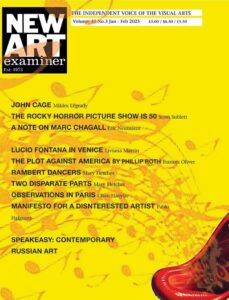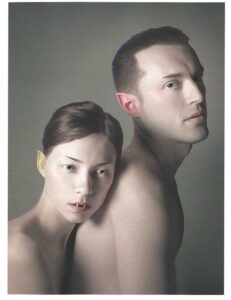
“Witness” is on view at the Museum of Contemporary Art from now though February 19, 2017. “The Making of a Fugitive” is on view through December 4, 2016.
A majority of the world’s population not only has access to the internet but also owns smart phones, according to Pew Research. This rapid expansion of technology generated a social space we are all familiar with but few people think about with critical consideration.
Being immersed in a world of mediation where we not only have access to a seemingly infinite number of images but also have the means to create and construct our own narratives of identity and power is, without question, shaping culture and communities in unprecedented ways.
Two exhibitions currently up at Chicago’s Museum of Contemporary Art probe the facets of this cultural moment.
“Witness” presents a selection of photographs that examine the dynamics between photographer, subject and viewer. The images are almost
all portraits or figures and those where the figure is absent deal with the body nevertheless, as is the case with Standing at the Grave of Emmett Till shot by John Lazarus.

The modes of figuration in the images range from the candid portraits of subway riders by Walker Evans to the staged film stills of Cindy Sherman. We see familiar heroic poses that could have pulled from classical painting in Rineke Dijkstra’s Hel, Poland, Aug 12, 1998 and Collier Schorr’s portrait of the artist Boychild titled Where are you Going?.
A less traditional treatment of the body are one of David Hockney’s photographic collages, Gregory loading his camera, where the body is fragmented as though the boundary between photographer and subject is temporarily dismantled in the moment of adding new film to the
camera. In Carrie Mae Weems’ Ebo Landing from the Sea Islands Series, two landscapes absent of any people are placed below and above text on a three panel frame.
The text recounts the chant Ibo men sang when they were brought to shore as slaves and, upon landing, defiantly walked back into the sea to drown. The written narrative juxtaposed with the images evokes the presence of the body without a visual representation of it. Instead, the
presence of the body is allocated to the viewer, further examining the notion of presence and body politics that can be mapped on to all parties
involved in the photographic image whether it be photographer, subject, or viewer.
This examination of roughly 70 years of image-making primes the viewer for the exhibition’s keystone work. Proceeding through the Neil-Fischel gallery, viewers pass by Anne Collier’s Negative. It is not only the single inverted photograph in the exhibition but it stands alone at the end of a hall leading to the next large room. I enjoyed it formally but wondered why it was there.
My attention was drawn to the aggressively glowing and densely installed fluorescent lights on the outside of a large box the size of small cabin. This is Alfredo Jaar’s The Sound of Silence. Seeing the wall of glowing lights, I immediately thought ‘giant camera’. It sounds like fun but feels very ominous. Going around to the opposite side of the structure, museum goers wait on a bench for a horizontal line of green lights to turn
on meaning they can enter. Sitting on three adjacent benches facing a screen we watch a highly dramatic text-based video that, in as few words
as possible, tells the story of Kevin Carter whose journalistic photograph of a tragic subject won him a Pulitzer Prize and possibly contributed to a
mental state that led to his suicide.
During this narrative, we see Carter’s photograph and are startled with an intense flash of bright light. The piece alone is powerful but, within the context of this exhibition, its inclusion may feel like a heavy-handed gesture. It is an essential one nonetheless in how it embodies the questioning of body politics and the gaze within the photographic gesture. The Sound of Silence makes it difficult not to engage in this confrontation of body, mind, and machine while having it all framed by a fact-based narrative where the seemingly harmless act of taking a photograph creates a moral and ethical dilemma with serious consequences.
Upon leaving the installation I looked back on Anne Collier’s Negative. Its placement made much more sense to me in how it seemed to be a
forewarning that some kind of photographic logic is about to be manipulated and flipped on its head as it was in Jaar’s piece. Nevertheless, I felt
as though my critical understanding of the nature of photography felt somewhat sharpened and my desire to examine the politics of the visual world had grown.
Though not directly connected by the curator, a second exhibition called “The Making of a Fugitive” continues the conversation of how
photography shapes social politics within existing power structures. Referring specifically to a 1970 Life magazine cover headline, the exhibition
attempts to unpack the word ‘fugitive’ as a romantic archetype in popular culture as well a construct of danger in society.
Outside the small gallery is a large wall piece by Dennis Adams titled Patricia Hearst – A thru Z. It is a series of photographs of Hearst arranged
in a grouping of 26, one for each letter of the alphabet. The images are pulled from various periodicals published during the 14-month period
in which Hearst was in the public eye as an innocent victim, a political prisoner turned radical and exonerated citizen. This selection of images
enables us to peer into the non-objective use of images to shape a public narrative through mediation, suggesting that the danger is not exclusive to fugitives themselves but also to manipulated consumers of said media.

The majority of the work is packed tightly into the small upper level galleries and the work could benefit from some breathing room but that does
not stifle the conversation completely. One could even argue that the density of the work displayed reflects the ever-expanding density of consumable media we face on a daily basis.
However, that is a stretch, considering the numerous same size galleries throughout the museum. In such close quarters, the works compete
with one another and the installations by David Hammons and Bruce Nauman pull most of that visual attention while Glen Ligon’s series,
Runaways, takes the shape of an exhaustive task in reading producing a conceptually poignant interaction with work.
Both exhibitions present viewers with deep investigations into the mediated world examining how the narratives constructed within this space
can shape our reality in ways we would do well to pay closer attention to. Both are provocative efforts toward deciphering the codes of our mediated world.
Evan Carter
Evan Carter hails from Worcester, Massachusetts. He studied Painting at Mass. College of Art in Boston and is currently an MFA candidate in the Department of Visual Art at the University of Chicago.
Volume 31 number 1, September / October 2016 pp 33-34

